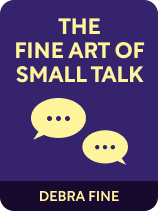

This article is an excerpt from the Shortform book guide to "The Fine Art of Small Talk" by Debra Fine. Shortform has the world's best summaries and analyses of books you should be reading.
Like this article? Sign up for a free trial here .
Do you want to master the art of small talk? How do you politely start and end a conversation with a stranger?
In her book The Fine Art of Small Talk, author Debra Fine teaches readers how to master the art of small talk. She goes over the four steps to a successful conversation, how to start a conversation with a stranger, how to end a conversation gracefully, and more.
Here is an overview of Debra Fine’s advice on how to master the art of small talk.
Mastering Small Talk
In The Fine Art of Small Talk, Debra Fine explains the benefits of mastering small talk and teaches you to confidently converse with strangers. According to Fine, the opportunity for casual conversations crops up many times each day—with neighbors, kids, and coworkers, and at social events, business lunches, and even the local supermarket. When we avoid small talk, she explains, we minimize the number of deep conversations we get to have in these settings. Furthermore, Fine says, we risk giving the impression that we’re cold, disinterested, or rude.
(Shortform note: Fine’s assertion that avoiding small talk can appear rude may seem a little unfair if you’re shy: Shy people avoid conversation not because they’re rude, but because they feel anxious or awkward. They want to connect, but they don’t know how. Unfortunately, though, others may not realize that shyness fuels this behavior: They might just assume that you’re rude or aloof. This is why it’s so important for shy people who want to connect to get out of their comfort zones and try to overcome their shyness.)
Fine’s Proactive Practice Mindset
Clearly, small talk is a valuable tool—but what if it doesn’t come naturally to you? The good news, according to Fine, is that anyone can learn the art of small talk: It’s just a matter of practice and mindset.
(Shortform note: When you want to learn or improve, your mindset—as Fine notes—affects how successful you can be. In particular, you’ll want to adopt a “growth mindset,” rather than a “fixed mindset.” When you hold a growth mindset, you remain open to improvement: You accept the belief that there’s no limit to how far learning and practice will take you. In contrast, those with a fixed mindset believe they’re limited to the traits, intelligence, and potential they were born with.)
According to Fine, taking the following principles to heart as you practice small talk will give you the best chance of improving:
1. If you want something, Fine says, go get it. If your goal is to meet new people, don’t just stand around alone or talk to people you already know. Instead, actively approach strangers.
(Shortform note: Why is being proactive so important? Stephen Covey, author of The 7 Habits of Highly Effective People, explains it’s because initiative is key to adopting new behaviors—it’s how we exert control over our circumstances. Covey might say that if you’re bad at small talk, it’s time to stop just letting small talk happen to you. Instead, accept that you’re having trouble, take responsibility for improving, and actively make an effort to change.)
2. According to Fine, it’s your job to start the conversation. The second most common fear in America is of starting conversations, particularly with strangers. Because this fear is so common, you’re unlikely to face rejection if you initiate conversation—in fact, your conversational partner is likely to be relieved that you made the effort.
(Shortform note: Contrary to Fine’s claim, America’s most common fears change year-to-year based on the circumstances we’re dealing with—a fear of conversing with strangers doesn’t usually make the top 10. At the time of The Fine Art’s publication, for example, it was often claimed that Americans’ number one fear was of public speaking, though fears of terrorist attacks sometimes polled higher. In 2021, the most common fears were of political corruption, the death of a loved one, or of a loved one contracting the coronavirus.)
3. It’s as much your job to carry the conversation as it is your partner’s, Fine notes. When you leave the hard work of maintaining conversation to someone else, you selfishly put your comfort ahead of theirs. Conversation is a two-player game, and you need to participate equally.
(Shortform note: Fine’s point that you have to learn to carry your weight echoes a common complaint that she implies, but doesn’t openly state: that too many people refuse to hold up their end of a conversation. If you want to be a better conversationalist, you must be willing to take charge and set the direction. Aim to do so multiple times in every encounter, to ensure you’re practicing this skill.)
The Four Steps to a Successful Conversation
Now that you understand it’s your responsibility to participate actively in conversations, we’ll delve into Fine’s four-step guide to a successful conversation.
Step 1: Choose a Partner and Introduce Yourself
Before you can start a conversation, you have to find someone to have that conversation with. When choosing someone to talk to, Fine recommends the following two-step process:
1. Scan the room and find someone who’s on their own, who’s not engaged in a conversation or an activity, and who makes eye contact with you.
(Shortform note: There are far more signals that someone doesn’t want to talk than Fine lists: Leave people alone if they’re wearing headphones, reading, crossing their arms or showing other “closed” body language, or if they turn away from you when you look at them.)
2. When you make eye contact, smile at the person. Fine explains that this shows the other party you’re interested in them and immediately establishes a rapport. When you smile at someone, their natural response is to smile back; right off the bat, the two of you share a positive feeling.
(Shortform note: Fine’s principle assumes that the other person will smile back; but what if they don’t? Is trying to connect then a lost cause? Probably: Research indicates that a genuine smile communicates a desire to engage cooperatively and altruistically. We can reverse this to imply that someone who doesn’t genuinely smile back doesn’t want to cooperate and converse with you.)
How to Introduce Yourself and Learn Their Name
Once you’ve chosen a conversational partner and established rapport through a smile, walk up to them, Fine suggests, make eye contact, smile again and shake their hand.
(Shortform note: Fine suggests handshaking because, in Western society, it’s the polite thing to do—but you don’t have to do it. If you don’t want to shake hands, the Harvard Business Review recommends you communicate warmth, friendliness, and respect in another way, such as by offering a small bow.)
Say, “Hi. My name is…” Then, stay focused as the other person returns the introduction. Remember their name and use it immediately: For instance, say “Nice to meet you, Albert!” If you miss a person’s name, Fine recommends asking them to repeat it. Remember that everyone has the right to be called by their name, she notes, and that those with difficult names will appreciate it.
(Shortform note: It’s not just people with difficult names who’ll appreciate your efforts: According to Dale Carnegie, everyone is thrilled when someone learns and uses their name. Carnegie argues that a person’s name is the most important word in any language to them—saying it is a subtle and welcome compliment. In contrast, forgetting a name or getting it wrong suggests you didn’t care enough to get it right. Use a person’s name often, he says, and respect it.)
Step 2: Start a Conversation
We’ve explored how to find a conversational partner and introduce yourself to them. Now that we’re ready to have a conversation, let’s explore how to start one.
How to Break the Ice
The first step in starting a conversation, Fine explains, is to break the ice. According to Fine, it doesn’t matter much what you say as an opener; in theory, you could say anything. What matters is that you initiate the conversation and show genuine interest in the other person’s answer. Her recommendation, if you’re having trouble, is to open with a statement that uses the context of the situation, event, or venue, and then ask them a related question.
If you’re afraid to talk to someone because you fear you’ll have nothing in common, Fine suggests you keep in mind that humans are more alike than they are different. If you give other people a chance, she says, you’ll find you can connect with almost anyone.
(Shortform note: You may feel doubtful that Fine is correct here; surely, considering the diverse range of cultures and life practices that exist across the world (and even within countries), it’s optimistic to say we can connect with almost anyone? However, according to research, Fine is correct: The human experience, broadly speaking, is less diverse than it seems. In a study spanning 62 countries around the world, researchers found that our daily experiences are largely universal. For instance, we all care about our friends, want to love and be loved, and enjoy laughing, companionship, and cooperation.)
| Easy Ways to Start Talking Sometimes, it’s hard to initiate a chat because you don’t know what to say—and hearing that you can talk about anything as an icebreaker, as Fine suggests, may overwhelm you, as it gives you too broad a list of possibilities. Fine does provide a specific list of icebreakers in her book, but most of them are business-focused or come too far out of the blue to be generally applicable—like, “I’m excited about our new mayor. How do you think her administration will differ from her predecessor’s?” Instead, here are some go-to styles of opener you can use in most contexts, and an example of each: Commiserate: “We’ve been waiting in line a long time, haven’t we? What brings you here today?” Notice something pleasant: “I’m so glad I came out for this concert; wasn’t that guitar solo incredible?” Compliment someone: “I really appreciated your presentation—the way you laid out the details made it easy to follow and understand.” Leverage Commonality: “I’m in marketing, too! How long have you been in the business?” Seek an opinion: “I’ve been thinking about attending this workshop, would you recommend it?” Ask for easy help: “Do you know when the food is supposed to arrive?” Help someone out: “That printer looks heavy, can I give you a hand?” |
Step 3: Keep the Conversation Going
Once you’ve gotten the conversation started, do your part to keep it flowing smoothly. Let’s explore two methods of prolonging conversation: asking open-ended questions that get people talking about themselves and using context clues to follow up on their answers.
How to Ask Open-Ended Questions
According to Fine, a conversation flows best when you create opportunities for your partner to share details you can explore more deeply. Therefore, ask your conversational partner open-ended questions that demand more than a one-word answer. Show interest and encourage them to talk about themselves: The more your partner gives you, Fine says, the more you’ll have to work with later. (Shortform note: You’ll see the value of open-ended questions more clearly in the upcoming section on following up on cues. For now, keep in mind that your goal is always to elicit more than a “yes,” or “no.”)
If your question elicits a one-word answer, ask another open-ended question. For example:
- Person A: “How was your vacation?”
- Person B: “Great!”
- Person A: “I’m glad to hear it! Did you do anything particularly exciting?”
- Person B: “Well, my brother and I went water skiing at the lake. We…”
However, Fine includes a caveat to this recommendation: Don’t push topics your partner doesn’t seem willing to engage in. You’re not here to interrogate them: Let them decide how much they’re comfortable saying. If they give a short answer and then steer the conversation elsewhere, Fine recommends you respect that and join them in the direction they’ve chosen.
(Shortform note: This principle is crucial because it prevents you from pressuring your partner to talk about certain things: Your conversation will go most smoothly if you give them space to control the topic. At this point, the conversation has only just started—and you want it to continue—so leave judgment, criticism, and interrogation behind.)
How to Follow Up on Cues With Additional Questions
Another way to keep conversations going is to follow up with additional open-ended questions. This is where Fine’s recommendation that you show interest in your partner’s answers yields fruit: When you pay attention to their responses, you’ll notice interesting details you can use to deepen the conversation.
You can choose follow-up questions based on any of the following:
1. Anything they’ve mentioned so far—did anything about their previous answers intrigue or interest you? Did they seem particularly proud of anything they brought up? (Shortform note: In particular, dig into the things people mention that are outside of their obligations. For instance, follow up on people’s hobbies, not their job. They’ll enjoy the conversation more if it’s focused on things they want to do than things they have to do.)
2. Things they’re wearing, particularly those which denote group membership. (Shortform note: Why is this such a useful conversational tool? Because a person who wears a Rotary Club pin or a Seattle Seahawks cap to an event is usually doing so for a reason—they’re signaling a personal interest they like to think or talk about. When talking to younger people, keep an eye out for things like cell phone charms, keyrings, pins on their bag or jacket, or stickers on a water bottle.)
3. Their achievements, trophies, and ornaments, especially those they display prominently. (Shortform note: This is particularly useful if you’re addressing someone whose achievements were recently announced (for instance, at a conference), but it’s just as helpful when you’re visiting someone’s home or office. People display what brings them happiness and pride—whether that’s a university diploma or a little figurine of a snail.)
4. The location or occasion. (Shortform note: When all else fails, you can always ask someone what brings them here, who they know and how they met them, or how they’re feeling about the event.)
5. Their behavior, traits, or quirks. (Shortform note: Fine suggests that the way someone speaks or writes can offer you opportunities for small talk—but be careful; it’s easy to offend someone this way. For example, don’t ask someone who seems to speak with a foreign accent “where are you really from?” Maybe they’re from the city you’re in and only picked up the accent from their parents.)
Step 4: End the Conversation
Eventually, no matter how engaging a conversation is, the time comes to move on. Furthermore, occasionally, a conversation isn’t engaging or enjoyable, and you might want to leave swiftly. In this final step, we’ll explore how to gracefully exit a conversation without burning any bridges.
How to Make Your Exit
Before you leave a conversation, Fine urges you to have a clear destination in mind and be honest about it. Make it clear that the reason you need to leave is that there’s something you need to do. For example, if your next goal is to get some food, speak to the event’s host, or make a call, courteously say so. When you’ve disengaged, do what you said you would: If your former conversational partner sees you doing something else, they’ll take it personally.
(Shortform note: Don’t worry if your reason for leaving isn’t very strong. Research shows that the word “because,” followed by a reason—even one that’s not compelling—leads to a much higher likelihood of acceptance of a situation. A Harvard psychologist, who had researchers try cutting in line to use the copy machine, discovered people were 34% more likely to allow the intrusion when the researchers said “because I need to make copies” than when they didn’t give a reason.)
Furthermore, Fine suggests that, when it’s time to leave, you thank your conversational partner for their expertise, their time, or the joy of conversing with them. A genuine compliment or expression of gratitude leaves the other person feeling good about you and gives you an air of confidence and poise.
(Shortform note: An additional important benefit of expressing gratitude at the end of a conversation is that it improves the likelihood of your conversational partner opting to stay connected with you long-term. Research shows that expressions of gratitude signal warmth, friendliness, and thoughtfulness—all of which contribute to a feeling in the recipient that the burgeoning relationship is worth investing in. For this reason, people you thank are more likely to give you their contact information or extend an invitation to spend time with them in future.)
Fine suggests that if you want to see the person again, you say so. Issue an invitation and don’t take it personally if you’re turned down.
(Shortform note: Fine doesn’t explain how to extend an invitation, or when to do it—just that you should mention you’d like to. Keith Ferrazzi, author of Never Eat Alone, gives more specific advice: He suggests following up on an initial contact between 12 and 24 hours later. When you do, he says, thank the person for their time or help, remind them of a part of your conversation—a joke they made, or a topic you agreed on—and suggest you meet again. You don’t have to set a time or invite them to anything specific right away—just express that you want to meet again, and let them know you’ll be in contact soon to discuss the details.)

———End of Preview———
Like what you just read? Read the rest of the world's best book summary and analysis of Debra Fine's "The Fine Art of Small Talk" at Shortform .
Here's what you'll find in our full The Fine Art of Small Talk summary :
- Why we need small talk and why we shouldn't avoid it
- How to appear confident and engaging in any context
- How to break the ice with strangers and keep the conversation going






